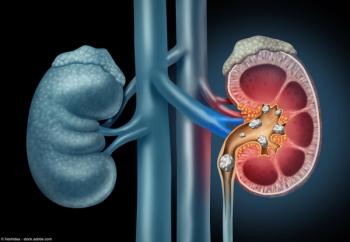
- Vol 53 No 08
- Volume 53
- Issue 08
Phase 3 TALAPRO-2 data of talazoparib plus enzalutamide published in The Lancet
Key Takeaways
- Talazoparib plus enzalutamide significantly improved OS in HRR-deficient and unselected mCRPC patients compared to enzalutamide alone.
- The FDA approved the combination for HRR-gene mutated mCRPC but declined broader approval for unselected patients.
In both cohorts, the combination of talazoparib plus enzalutamide led to a significant improvement in overall survival vs enzalutamide alone.
Data from both cohorts of the phase 3 TALAPRO-2 trial (NCT03395197) have been published in concurrent publications in The Lancet, looking at the combination of talazoparib (Talzenna) plus enzalutamide (Xtandi) in patients with homologous recombinant repair (HRR)-deficient metastatic castration-resistant prostate cancer (mCRPC)1 and in those unselected for HRR gene mutations.2
In both cohorts, the combination of talazoparib plus enzalutamide led to a significant improvement in overall survival (OS) vs enzalutamide alone.
In June 2023, the combination of talazoparib plus enzalutamide was FDA approved for patients with HRR-gene mutated mCRPC based on findings from the TALAPRO-2 trial.3
"In the final overall survival analysis, the trial demonstrated an unprecedented 14-month improvement in OS and a nearly 40% reduction in the risk of death when talazoparib was added to enzalutamide in mCRPC patients with HRR gene mutations," commented TALAPRO-2 co-author Neeraj Agarwal, MD, FASCO, in correspondence with Urology Times®.
The FDA recently declined to approve an expanded indication for the combination for broader use in the treatment of patients with mCRPC who do not harbor HRR gene mutations.4 The agency’s decision followed a
The TALAPRO-2 trial remains ongoing, with final completion expected in June 2027.5
HRR-deficient cohort
The HRR-deficient cohort of the TALAPRO-2 trial included 399 patients who were randomly assigned 1:1 to receive talazoparib plus enzalutamide (n = 200) or to enzalutamide plus placebo (n = 199). Patients were enrolled through 142 clinical trial sites across 26 countries. The dual primary end points were OS and radiographic progression-free survival (rPFS).
At a median follow-up of 44.2 months, the combination of talazoparib plus enzalutamide led to a statistically significant and clinically meaningful improvement in OS vs placebo plus enzalutamide (HR, 0.62; 95% CI, 0.48 to 0.81; two-sided P = .0005). Specifically, the median OS was 45.1 months (95% CI, 35.4 to not reached) in the combination arm vs 31.1 months (95% CI, 27.3 to 35.4) in the enzalutamide monotherapy arm.
Further, the median radiographic progression-free survival (rPFS) was 30.7 months (95% CI, 24.3 to 38.5) in the combination arm vs 12.3 months (95% CI, 11.0 to 16.5) in the enzalutamide only arm. Consistent with the study’s primary analysis, time to prostate-specific antigen (PSA) progression, time to initiation of cytotoxic chemotherapy, and investigator-assessed time to progression or death on first subsequent antineoplastic therapy favored the talazoparib arm.
The combination also showed particular benefit in the subgroup of patients with BRCA1/2 alterations (n = 155). In this subgroup, the median OS was not reached in the talazoparib arm vs 28.5 months in the placebo arm (HR, 0.50; 95% CI, 0.32 to 0.78; P = .0017).
In patients without BRCA1/2 alterations, the median OS was 42.4 months in the talazoparib arm vs 32.6 months in the placebo arm (HR, 0.73; 95% CI, 0.52 to 1.02; P = .066).
The safety profile for the combination was consistent with prior analyses. The most common adverse events (AEs) of grade 3 or higher among those in the combination arm were anemia (43%) and neutropenia (20%).
Agarwal added, "As recommended by most national guidelines, including those from ASCO, all patients with advanced prostate cancer should undergo germline testing and tumor genomic profiling to identify actionable mutations, such as those in HRR genes. The TALAPRO-2 study shows that patients with HRR gene mutations experience significantly improved survival when treated with talazoparib. Furthermore, identifying these mutations can have significant implications for family members, who may carry the same germline alterations and benefit from cancer risk assessment and preventive strategies."
HRR-unselected cohort
The cohort of patients unselected for HRR gene alterations included 805 participants who were randomly assigned 1:1 to receive talazoparib plus enzalutamide (n = 402) or to placebo plus enzalutamide (n = 403). Patients were enrolled in this cohort through 200 clinical trial sites across 26 countries. The trial’s co-primary end points were OS and rPFS.
At a median follow-up of 52.5 months, the addition of talazoparib to enzalutamide led to a significant improvement in OS vs enzalutamide alone (HR, 0.80; 95% CI, 0.66 to 0.96; P = .016). Specifically, the median OS was 45.8 months (95% CI, 39.4 to 50.8) in the combination arm vs 37.0 months (95% CI, 34.1 to 40.4) in the monotherapy arm.
The authors wrote, “Overall survival favored talazoparib plus enzalutamide over enzalutamide plus placebo in HRR-deficient patients (n = 169; HR, 0.55; 0.36 to 0.83; P = .0035) and to a lesser extent in HRR-non-deficient or unknown patients (n = 636; HR, 0.88; 0.71 to 1.08; P = .22).”
rPFS data also favored the combination across the whole cohort. Specifically, the median rPFS was 33.1 months in the talazoparib arm vs 19.5 months in the placebo arm (HR, 0.67; 0.55 to 0.81; P < .0001).
There were no new safety signals with talazoparib. The most common AEs of grade 3 or higher were anemia (49% vs 4%, combination vs monotherapy arm, respectively) and neutropenia (19% vs 1%, respectively).
REFERENCES
1. Fizazi K, Azad AA, Matsubara N, et al. Talazoparib plus enzalutamide in men with HRR-deficient metastatic castration-resistant prostate cancer: final overall survival results from the randomised, placebo-controlled, phase 3 TALAPRO-2 trial. The Lancet. 2025. doi:10.1016/S0140-6736(25)00683-X
2. Agarwal N, Azad AA, Carles J, et al. Talazoparib plus enzalutamide in men with metastatic castration-resistant prostate cancer: final overall survival results from the randomised, placebo-controlled, phase 3 TALAPRO-2 trial. The Lancet. 2025. doi:10.1016/S0140-6736(25)00684-1
3. FDA approves talazoparib with enzalutamide for HRR gene-mutated metastatic castration-resistant prostate cancer. News release. US Food & Drug Administration. June 20, 2023. Accessed July 18, 2025. https://www.fda.gov/drugs/drug-approvals-and-databases/fda-approves-talazoparib-enzalutamide-hrr-gene-mutated-metastatic-castration-resistant-prostate
4. Pfizer provides update on U.S. regulatory review of TALZENNA in combination with XTANDI for broader use in metastatic castration-resistant prostate cancer. News release. Pfizer. June 13, 2025. Accessed July 18, 2025. https://www.pfizer.com/news/announcements/pfizer-provides-update-us-regulatory-review-talzenna-combination-xtandi-broader
5. Talazoparib + enzalutamide vs. enzalutamide monotherapy in mCRPC (TALAPRO-2). ClinicalTrials.gov. Last updated July 17, 2025. Accessed July 18, 2025. https://clinicaltrials.gov/study/NCT03395197
Articles in this issue
Newsletter
Stay current with the latest urology news and practice-changing insights — sign up now for the essential updates every urologist needs.



















